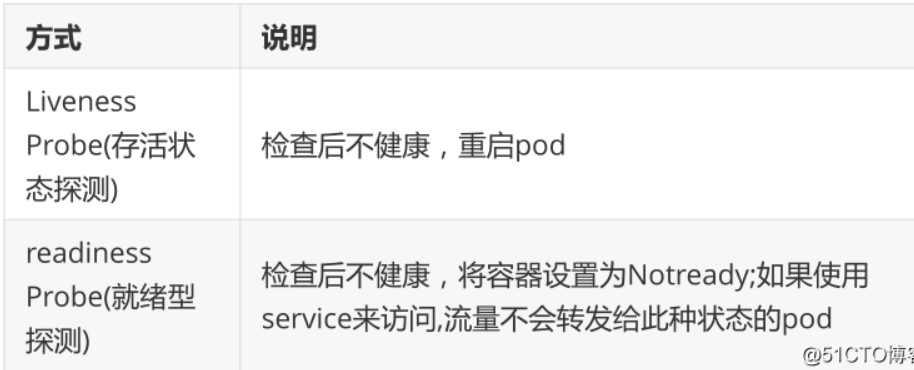目录
一.声明式资源管理
声明式资源管理方法:声明式资源管理方法依赖于一资源配置清单(yaml/json)文件对资源进行管理,对资源的管理,是通过事先定义在统一资源配置清单内,再通过陈述式命令应用到K8s集群里。
语法格式:kubectl create/apply/delete/edit -f /path/to/yaml
1.1 查看资源配置清单的方法
kubectl get svc nginx-dp -o yaml -n kube-public
1.2 解释资源配置清单
kubectl explain service
1.3 创建资源配置清单
vi /root/nginx-ds-svc.yaml
1.4 修改资源配置清单
# 离线修改
vi nginx-ds-svc.yaml文件,并用kubectl apply -f nginx-ds-svc.yaml文件使之生效
# 在线修改
kubectl edit service nginx-ds
1.5 应用资源配置清单
kubectl apply -f nginx-ds-svc.yaml
1.6 删除资源配置清单
# 陈述式删除
kubectl delete service nginx-ds -n kube-public
# 声明式删除
kubectl delete -f nginx-ds-svc.yaml
1.7 YAML文件创建讲解
资源类型与apiVersion对照表
| kind | apiVersion |
|---|---|
| ClusterRoleBinding | rbac.authorization.k8s.io/v1 |
| ClusterRole | rbac.authorization.k8s.io/v1 |
| ConfigMap | v1 |
| CronJob | batch/v1beta1 |
| DaemonSet | extensions/v1beta1 |
| Node | v1 |
| Namespace | v1 |
| Secret | v1 |
| PersistentVolume | v1 |
| PersistentVolumeClaim | v1 |
| Pod | v1 |
| Deployment | v1、apps/v1、apps/v1beta1、apps/v1beta2 |
| Service | v1 |
| Ingress | extensions/v1beta1 |
| ReplicaSet | apps/v1、apps/v1beta2 |
| Job | batch/v1 |
| StatefulSet | apps/v1、apps/v1beta1、apps/v1beta2 |
cat create_namespace.yml
# 必选,api版本号
apiVersion: v1
# 必选,类型为pod
kind: pod
# 必选,定义元数据
metadata:
# 必选,pod名称
name: string
# pod所属的命名空间,默认在default的namespace
namespace: string
# 自定义标签
lables:
# 自定义标签名字
- name: string
# 自定义注释列表
annotations:
- name: string
# pod中容器的详细定义(期望)
spec:
# 通过nodeName调度到node1节点
nodeName: node1
# nodeSelector节点选择器
nodeSelector:
# 指定调度到标签为bussiness=game的节点
bussiness: game
# 必选,pod中容器列表
containers:
# 必选,容器名称
- name: string
# 必选,容器的镜像名称
image: string
# 获取镜像的策略,Alawys表示下载镜像,IfNotPresent表示优先使用本地镜像,否则下载镜像,Never表示仅使用本地镜像
imagePullPolicy: [Always | Never | IfNotPresent]
# 容器的启动命令列表,如不指定,使用打包时使用的启动命令
command: [string]
# 容器的启动命令参数列表
args: [string]
# 容器的工作目录
workingDir: string
# 挂载到容器内部的存储卷位置
volumeMounts:
# 引用pod定义的共享存储卷的名称,需用volumes[]部分定义的卷名
- name: string
# 存储卷在容器内mount的绝对路径,应少于512字符
mountPath: string
# 是否为只读模式
readOnly: boolean
# 需要暴露的端口号列表
Ports:
# 端口号名称
- name: string
# 容器需要监听的端口号
containerPort: int
# 容器所在宿主机需要监听的端口号,默认与Container相同
hostPort: int
# 端口协议,支持TCP和UDP,默认TCP
protocol: string
# 容器运行前需设置的环境变量列表
env:
# 环境变量名称
- name: string
# 环境变量的值
value: string
# 资源限制和请求的设置
resources:
# 资源限制的设置
limits:
# cpu的限制,单位为core数,将用于docker run --cpu-shares参数
cpu: string
# 内存限制,单位可以为Mib/Gib,将用于docker run --memory参数
memory: string
# 资源请求的限制
requests:
# cpu请求,容器启动的初始可用数量
cpu: string
# 内存请求,容器启动的初始可用数量
memory: string
# 对Pod内个容器健康检查的设置,当探测无响应几次后将自动重启该容器,检查方法有exec、httpGet和tcpSocket,对一个容器只需设置其中一种方法即可
livenessProbe:
# 对Pod容器内检查方式设置为exec方式
exec:
# exec方式需要制定的命令或脚本
command:
- cat
- /tmp/healthy
# 对Pod内个容器健康检查方法设置为HttpGet,需要制定path、port
httpGet:
path: string
port: number
host: string
scheme: string
HttpHeaders:
- name: string
value: string
# 对Pod内个容器健康检查方式设置为tcpSocket方式
tcpSocket:
port: number
# 容器启动完成后首次探测的时间,单位为秒,pod启动延迟5秒后探测
initialDelaySeconds: 0
# 对容器健康检查探测等待响应的超时时间,单位秒,默认1秒
timeoutSeconds: 0
# 对容器监控检查的定期探测时间设置,单位秒,默认10秒一次
periodSeconds: 0
successThreshold: 0
failureThreshold: 0
securityContext:
privileged: false
# Pod的重启策略,Always表示一旦不管以何种方式终止运行,kubelet都将重启,OnFailure表示只有Pod以非0退出码退出才重启,Never表示不再重启该Pod
restartPolicy: [Always | Never | OnFailure]
# 设置NodeSelector表示将该Pod调度到包含这个label的node上,以key:value的格式指定
nodeSelector: obeject
# pull镜像时使用的secret名称,以key:secretkey格式指定
imagePullSecrets:
- name: string
# 是否使用主机网络模式,默认为false,如果设置为true,表示使用宿主机网络
hostNetwork: false
# 在该pod上定义共享存储卷列表
volumes:
# 共享存储卷名称 (volumes类型有很多种)
- name: string
# 类型为emtyDir的存储卷,与Pod同生命周期的一个临时目录,为空值
emptyDir: {}
# 类型为hostPath的存储卷,表示挂载Pod所在宿主机的目录
hostPath: string
# Pod所在宿主机的目录,将被用于同期中mount的目录
path: string
# 类型为secret的存储卷,挂载集群与定义的secret对象到容器内部
secret:
scretname: string
items:
- key: string
path: string
# 类型为configMap的存储卷,挂载预定义的configMap对象到容器内部
configMap:
name: string
items:
- key: string
path: string
1.7.1 HealthCheck健康检查
当Pod启动时,容器可能会因为某种错误(服务未启动或端口不正确)而无法访问等。
kubelet拥有两个检测器,它们分别对应不同的触发器(根据触发器的结构执行进一步的动作)
1.7.1.1 Health Check方式

1.7.1.2 Probe探测方式

1.7.1.3 案例1: liveness-exec
vim pod-liveness-exec.yml
apiVersion: v1
kind: Pod
metadata:
name: liveness-exec
namespace: default
spec:
containers:
- name: liveness
image: busybox
imagePullPolicy: IfNotPresent
args:
- /bin/sh
- -c
- touch /tmp/healthy; sleep 30; rm -rf /tmp/healthy;
sleep 600
livenessProbe:
exec:
command:
- cat
- /tmp/healthy
# pod启动延迟5秒后探测
initialDelaySeconds: 5
# 每5秒探测1次
periodSeconds: 5
kubectl apply -f pod-liveness-exec.yml
kubectl describe pod liveness-exec
1.7.1.4 案例2: liveness-httpget
vim pod-liveness-httpget.yml
apiVersion: v1
kind: Pod
metadata:
name: liveness-httpget
namespace: default
spec:
containers:
- name: liveness
image: nginx:1.15-alpine
imagePullPolicy: IfNotPresent
# 指定容器端口,这一段不写也行,端口由镜像决定
ports:
# 自定义名称,不需要与下面的port: http对应
- name: http
# 类似dockerfile里的expose 80
containerPort: 80
livenessProbe:
# 使用httpGet方式
httpGet:
# http协议,也可以直接写80端口
port: http
# 探测家目录下的index.html
path: /index.html
# 延迟3秒开始探测
initialDelaySeconds: 3
# 每隔5s钟探测一次
periodSeconds: 5
kubectl apply -f pod-liveness-httpget.yml
kubectl get pods
kubectl exec -it liveness-httpget -- rm -rf /usr/share/nginx/html/index.html
kubectl describe pod liveness-http | tail
1.7.1.5 案例3: liveness-tcp
vim pod-liveness-tcp.yml
apiVersion: v1
kind: Pod
metadata:
name: liveness-tcp
namespace: default
spec:
containers:
- name: liveness
image: nginx:1.15-alpine
imagePullPolicy: IfNotPresent
ports:
- name: http
containerPort: 80
livenessProbe:
# 使用tcp连接方式
tcpSocket:
# 连接80端口进行探测
port: 80
initialDelaySeconds: 3
periodSeconds: 5
kubectl apply -f pod-liveness-tcp.yml
kubectl get pod
kubectl exec -it liveness-tcp --/usr/sbin/nginx -s stop
kubectl describe pod liveness-http | tail -8
1.7.1.6 案例4: readiness
vim pod-readiness-httpget.yml
apiVersion: v1
kind: Pod
metadata:
name: readiness-httpget
namespace: default
spec:
containers:
- name: readiness
image: nginx:1.15-alpine
imagePullPolicy: IfNotPresent
ports:
- name: http
containerPort: 80
# 这里由liveness换成了readiness
readinessProbe:
httpGet:
port: http
path: /index.html
initialDelaySeconds: 3
periodSeconds: 5
kubectl apply -f pod-readiness-httpget.yml
kubectl get pod
kubectl exec -it readiness-httpget -- rm-rf /usr/share/nginx/html/index.html
kubectl get pod
kubectl exec -it readiness-httpget --touch /usr/share/nginx/html/index.html
1.7.1.7 案例5: readiness+liveness综合
vim pod-readiness-liveiness.yml
apiVersion: v1
kind: Pod
metadata:
name: readiness-liveness-httpget
namespace: default
spec:
containers:
- name: readiness-liveness
image: nginx:1.15-alpine
imagePullPolicy: IfNotPresent
ports:
- name: http
containerPort: 80
livenessProbe:
httpGet:
port: http
path: /index.html
initialDelaySeconds: 1
periodSeconds: 3
readinessProbe:
httpGet:
port: http
path: /index.html
initialDelaySeconds: 5
periodSeconds: 5
kubectl apply -f pod-readiness-liveiness.yml
kubectl get pod # 十秒前执行
kubectl get pod # 十秒后执行




 浙公网安备 33010602011771号
浙公网安备 33010602011771号